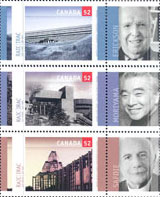Honouring McGill's stamp on Canada's cultural landscape
Honouring McGill's stamp on Canada's cultural landscape McGill University
User Tools (skip):
Honouring McGill's stamp on Canada's cultural landscape
To mark the 100th anniversary of the Royal Architectural Institute of Canada (RAIC), Canada Post has issued a set of stamps depicting four notable Canadian architects— three of them graduates of McGill University.
"The architects whose works are celebrated on these stamps are four of Canada's best known 'architects laureate,'" said Prof. David Covo, director of the McGill School of Architecture. "The fact that three of the four are McGill grads is more than coincidence; it's evidence of the role that McGill grads have played, and continue to play, not only in the design and construction of our built environment but also in the shaping of the profession itself."

McGill trio: stamped by greatness.
Each stamp in the set of four features an image of a Canadian architect who has received both the RAIC Gold Medal and the Order of Canada, along with a landmark work: Douglas Cardinal, St. Mary's Church (1969); Arthur Erickson, University of Lethbridge (1971); Raymond Moriyama, Ontario Science Centre (1969); and Moshe Safdie, National Gallery of Canada (1988). Erickson and Safdie both received their bachelor of architecture degrees at McGill, where Moriyama earned his master of architecture. All three also hold Honorary Doctorates from the University.
"These buildings—not only great but iconic works of architecture—have become part of Canada's cultural landscape," said Covo. "They are as much a part of our national identity as Niagara Falls, the Canadian Pacific railroad and the Rocky Mountains."
Canada Post unveiled the stamps during the May 10 opening luncheon of the annual Festival of Architecture in Toronto.
"Stamps evoke a sense of pride in Canadiana, whether they relate to Canadian history, traditions or accomplishments," said Canada Post Vice-President, Communications, Anthony Wilson-Smith. "These stamps recognize the importance of architecture to our Canadian culture, economy and quality of life."
Founded in 1907, what eventually became known as the Royal Architectural Institute of Canada today represents more than 3,500 professional architects, facility members and graduates of accredited Canadian University Schools of Architecture.
The McGill School of Architecture was established in 1896, when McGill benefactor Sir William C. Macdonald endowed a chair in architecture. One of its early professors, Percy Nobbs, along with 1899 McGill Architecture graduate George Taylor Hyde, designed such familiar local landmarks as the New Birks Building on Cathcart Street (1911); the University Club of Montreal on Mansfield Street (1912); the Osler Memorial Library (1921) and the Drummond Medical Building on Drummond Street (1929). As well, John Bland, a director of the school in the 1940s, was involved in the prize-winning design of Ottawa City Hall (1957-59), as well as McGill's Chancellor Day Hall (1965), Pollack Hall (1973), and the Labyrinth at Montreal's Expo '67.

